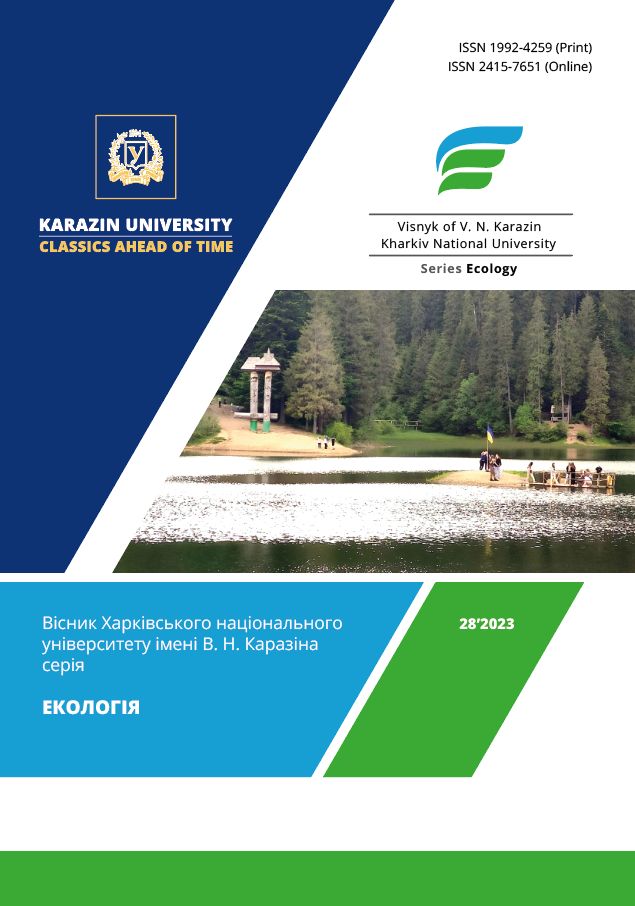Thermodynamic approaches in the study of environmental problems
Abstract
Purpose. Analysis from the thermodynamic point of view of the causes of global environmental problems and the possibilities of overcoming them.
Results. The application of the laws of thermodynamics to attempts to solve environmental problems is analyzed. The existence of life and the biosphere as a whole is determined by the flow of energy, the intensity of which per unit weight of living beings significantly exceeds the specific intensity of energy transformation in the Sun. From the second law of thermodynamics, a conclusion is made about the objectivity of environmental pollution, since the efficiency of energy transformation is always less than 100%, and is 1-50%. The remaining part of the degraded energy is the main cause of environmental pollution. The emergence of many global environmental problems is directly related to this part of energy. There is continuous exponential growth in both population and energy consumption. A critical overview of the existence and development of global environmental problems is given. The development of population growth is predicted for the current century.
Conclusions. Possible ways to overcome global environmental problems are discussed. The need to develop a new paradigm of human interaction with the environment is confirmed.
Downloads
References
Bezsonnyi, V., Tretyakov, O., Sherstyuk, M., & Nekos, A. (2022). Thermodynamic aspects of the sys-tems approach in ecology. Visnyk of V. N. Karazin Kharkiv National University, Series "Geology. Ge-ography. Ecology; (57), 268-281. https://doi.org/10.26565/2410-7360-2022-57-20
Myronchuk, Yu. (1998). Thermodynamic aspects of the analysis of ecological processes. Visnyk of DAAU, (1), 60–68. (in Ukrainian).
Sytnyk, K., & Bagnyuk, V. (2006). Biosphere and climate: past, present and future. Visn. Nac. Akad. Nauk Ukr., (9), 3-20. (in Ukrainian).
Kravchenko, K. O. (2022). To the question of research of geo-ecological problems of urbanization pro-cesses in the aspect of the concept of sustainable development. Man and Environment. Issues of Neoe-cology, 38, 6-19. https://doi.org/10.26565/1992-4224-2022-38-01
Yeremeev, V., & Yefimov, V. (2003). Regional aspects of global climate change. Visn. Nac. Akad. Nauk Ukr., (2), 14-19. (in Ukrainian).
Barabash, M., Hrebenyuk, N., & Tatarchuk, O. (1998). Climate change under global warming. Water management of Ukraine, (3), 9–12. (in Ukrainian).
Rudyy, B. (2003). Critique of evolutionism. Kyiv: The Fourth Wave. (in Ukrainian).
Didukh, Ya.P. (2014). Assessment of stability and risk of loss of ecosystems. Scientific notes of National University of Kyiv-Mohyla Academy, 158, (Biology and ecology), 54-60. [In Ukrainian]
Sytnyk, K., & Bagnyuk, V. (2005). Global warming: the contribution of atomic energy. Visn. Nac. Akad. Nauk Ukr., (6), 3-16. (in Ukrainian).
Sytnyk, K. (2003). Noosphere: myths and reality. Visn. Nac. Akad. Nauk Ukr., (5), 45-53. (in Ukraini-an).
Lorinus, Calange, Oeschger, Hans. (1994). Climate change. Paleoperspectives: reducing uncertainties in global change? AMBIO. 23, (1), 30—36.
Cherevatskyi, D. (2021). Quality of life dependence on energy consumption: intercountry variations. Demography and Social Economy, 45(3), 144–157. https://ojs.dse.org.ua/index.php/dse/article/view/28
BP Statistical Review of World Energy. Retrieved from https://www.bp.com/en/global/corporate/energy-economics/statistical-review-of-world-energy.html
Cook, E. The Flow of Energy in an Industrial Society. Scientific American. 1971225(3), 134–147. Re-trieved from http://www.jstor.org/stable/24923122
Franklin, D. & Andrews, J. (2012). Megachange: The World in 2050. Published March 27-th, 2012 by Wiley. Retrieved from http://homes.ieu.edu.tr/odikkaya/FA313_2013/Project1_Assignment/megachange.pdf
and 2020 World Population and Housing Census Programmes. (2015). Statistical Commission, Forty-sixth session 3-6 March 2015. Retrieved from http://www.un.org/ga/search/view_doc.asp?symbol=E/CN.3/2015/6
Demographic statistics. (2017). Report of the Secretary-General. Statistical Commission. Forty-eighth session, 7-10 March 2017. Retrieved from http://undocs.org/en/E/CN.3/2017/19
Demographic Yearbook 2015. (2016). Department of Economic and Social Affairs, United Nations. New York, Retrieved from https://unstats.un.org/unsd/demographic/products/dyb/dybsets/2015.pdf
Golyandina N., Nekrutkin V., & Zhigljavsky A. (2001). Analysis of Time Series Structure: SSA and Related Techniques. Boca Raton: Chapman & Hall/CRC.
Standard country or area codes for statistical use. United Nations. 2017. Retrieved from https://unstats.un.org/unsd/methodology/m49/
World Population Prospects. (2015). The 2015 Revision. Methodology of the United Nations Popula-tion Estimates and Projections. United Nations. New York. Retrieved from https://esa.un.org/unpd/wpp/Publications/Files/WPP2015_Methodology.pdf
World Population Prospects. (2015). The 2015 Revision. Population Devision. United Nations. New York, Retrieved from http://esa.un.org/unpd/wpp/DataSources/
World Urbanization Prospects. The 2014 Revision. Highlights. United Nations. New York. 2014. Re-trieved from https://esa.un.org/unpd/wup/publications/files/wup2014-highlights.Pdf
Lacusic B., Lacusic D., Jancic R., & Stevanovic D. (2006). Morphoanatomical differentation of the Balcan populations of the species Teucrium flavum L. (Lamiaceae). Flora. 201(1), 108—119. https://doi.org/10.1016/j.flora.2005.05.001
Capman, C.R. (2002). Impact of lethality and riscs in today world: lessons for interpreting earth histo-ry. In Koeberl C., Mac-Leod K.G. (Eds.). Catastrophic events and mass extinctions: Impact and beyond. Boulder, Colorado. Geol. Soc. Amer. P. 356—370. https://doi.org/10.1130/0-8137-2356-6.7
Petit, J.R., Jouzel, J., Raynaud, D., Barkov, N.I., Barnola, J.-M. et al. (1999). Climate and atmospheric history of the past 420,000 years from the Vostok ice core, Antarctica. Nature, 399, 429–436. https://doi.org/10.1038/20859
Keeling, R.F., Piper, A.F. Bollenbacher, & Walker J.S. (2009). Atmospheric CO2 records from sites in the SIO air sampling network. In Trends: A Compendium of Data on Global Change. Carbon Dioxide Information Analysis Center, Oak Ridge National Laboratory, U.S. Department of Energy, Oak Ridge, Tenn., U.S.A. https://doi.org/10.3334/CDIAC/atg.035
Copyright (c) 2023 Bezsonnyi, V. L.

This work is licensed under a Creative Commons Attribution 4.0 International License.
Authors who publish with this journal agree to the following terms:
- Authors retain copyright and grant the journal right of first publication of this work under the terms of a license Creative Commons Attribution License 4.0 International (CC BY 4.0).
- Authors are able to enter into separate, additional contractual arrangements for the non-exclusive distribution of the journal's published version of the work (e.g., post it to an institutional repository or publish it in a book), with an acknowledgement of its initial publication in this journal.
- Authors are permitted and encouraged to post their work online (e.g., in institutional repositories or on their website) prior to and during the submission process, as it can lead to productive exchanges, as well as earlier and greater citation of published work.





